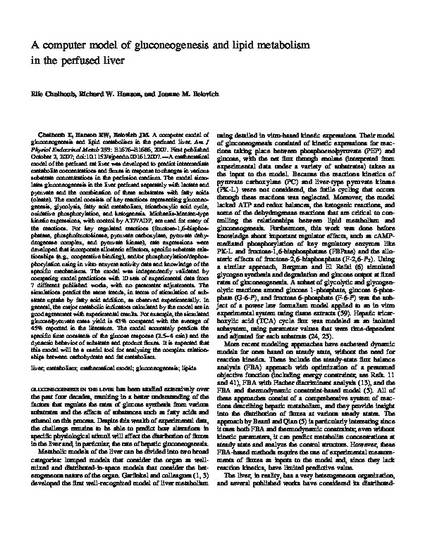
A mathematical model of the perfused rat liver was developed to predict intermediate metabolite concentrations and fluxes in response to changes in various substrate concentrations in the perfusion medium. The model simulates gluconeogenesis in the liver perfused separately with lactate and pyruvate and the combination of these substrates with fatty acids (oleate). The model consists of key reactions representing gluconeogenesis, glycolysis, fatty acid metabolism, tricarboxylic acid cycle, oxidative phosphorylation, and ketogenesis. Michaelis-Menten-type kinetic expressions, with control by ATP/ADP, are used for many of the reactions. For key regulated reactions (fructose-1,6-bisphosphatase, phosphofructokinase, pyruvate carboxylase, pyruvate dehydrogenase complex, and pyruvate kinase), rate expressions were developed that incorporate allosteric effectors, specific substrate relationships (e.g., cooperative binding), and/or phosphorylation/dephosphorylation using in vitro enzyme activity data and knowledge of the specific mechanisms. The model was independently validated by comparing model predictions with 10 sets of experimental data from 7 different published works, with no parameter adjustments. The simulations predict the same trends, in terms of stimulation of substrate uptake by fatty acid addition, as observed experimentally. In general, the major metabolic indicators calculated by the model are in good agreement with experimental results. For example, the simulated glucose/pyruvate mass yield is 43% compared with the average of 45% reported in the literature. The model accurately predicts the specific time constants of the glucose response (2.5–4 min) and the dynamic behavior of substrate and product fluxes. It is expected that this model will be a useful tool for analyzing the complex relationships between carbohydrate and fat metabolism.
Available at: http://works.bepress.com/joanne_belovich/22/

This work was supported by the Center for Modeling Integrated Metabolic Systems [National Institutes of Health (NIH) Grant P50-GM-066309], the Biomedical and Health Institute at Cleveland State University, and by NIH Grant DK-25541 to R. W. Hanson.